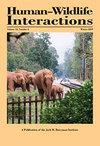无线电标记欧洲椋鸟在城市、农村和远郊景观中的运动行为
IF 0.9
4区 环境科学与生态学
Q4 BIODIVERSITY CONSERVATION
引用次数: 3
摘要
欧洲椋鸟(Sturnus vulgaris)自19世纪被有意引入美国以来,已经成为第四大最常见的鸟类,在城市和农村地区都是一种讨厌的鸟类害虫。管理人员需要更好地了解椋鸟的运动和习惯使用模式,以有效地管理椋鸟种群及其造成的损害。因此,我们重新审视了2005年至2010年秋季或冬季进行的6项无线电遥测研究,以比较3种景观中椋鸟的运动(n = 63只鸟)和栖息地的使用情况。在栖息地稀疏的乡村景观中,栖息地和觅食地点的转换导致白天(0900-1500小时)无线电固定距离比城市或郊区景观平均距离远2.6 - 6.3倍(P < 0.001)。在6-13公里以外的工业区,城市中心的栖息地较小(10万只)。有无线电标记的鸟类偶尔会从城市中心的栖息地转移到偏远的主要栖息地。一个多轨铁路立交桥和一个树木缓冲区被用作城市景观的主要栖息地。鸟类从郊区和乡村的主要觅食地飞往栖息地,通常会经过较近的小栖息地,到达大型湿地中新兴植被林分的主要栖息地。白天最小凸多边形的范围为101-229 km2 (x ā = 154 km2)。人为食物资源(如集中的动物饲养作业、航运场、垃圾填埋场和屠宰场)是主要的觅食场所。野生动物资源管理者可以利用这些信息来预测潜在的栖息和觅食地点以及在不同景观中实施项目时要监测的平均区域。除了跟踪栖息飞行,我们建议在实施致命捕杀(例如有毒诱饵)之前,查看高分辨率航拍图像,以确定潜在的栖息和觅食栖息地。本文章由计算机程序翻译,如有差异,请以英文原文为准。
Movement Behavior of Radio-Tagged European Starlings in Urban, Rural, and Exurban Landscapes
Since their intentional introduction into the United States in the 1800s, European starlings (Sturnus vulgaris) have become the fourth most common bird species and a nuisance bird pest in both urban and rural areas. Managers require better information about starling movement and habit-use patterns to effectively manage starling populations and the damage they cause. Thus, we revisited 6 radio-telemetry studies conducted during fall or winter between 2005 and 2010 to compare starling movements (n = 63 birds) and habitat use in 3 landscapes. Switching of roosting and foraging sites in habitat-sparse rural landscapes caused daytime (0900–1500 hours) radio fixes to be on average 2.6 to 6.3 times further from capture sites than either urban or exurban landscapes (P < 0.001). Roosts in urban city centers were smaller (<30,000 birds, minor roosts) than major roosts (>100,000 birds) 6–13 km away in industrial zones. Radio-tagged birds from city-center roosts occasionally switched to the outlying major roosts. A multitrack railroad overpass and a treed buffer zone were used as major roosts in urban landscapes. Birds traveling to roosts from primary foraging sites in exurban and rural landscapes would often pass over closer-lying minor roosts to reach major roosts in stands of emergent vegetation in large wetlands. Daytime minimum convex polygons ranged from 101–229 km2 (x̄ = 154 km2). Anthropogenic food resources (e.g., concentrated animal feeding operations, shipping yards, landfills, and abattoirs) were primary foraging sites. Wildlife resource managers can use this information to predict potential roosting and foraging sites and average areas to monitor when implementing programs in different landscapes. In addition to tracking roosting flights, we recommend viewing high-resolution aerial images to identify potential roosting and foraging habitats before implementing lethal culls (e.g., toxicant baiting).
求助全文
通过发布文献求助,成功后即可免费获取论文全文。
去求助
来源期刊

Human–Wildlife Interactions
Environmental Science-Nature and Landscape Conservation
CiteScore
2.80
自引率
0.00%
发文量
0
审稿时长
11 weeks
期刊介绍:
Human–Wildlife Interactions (HWI) serves the professional needs of the wildlife biologist and manager in the arena of human–wildlife conflicts/interactions, wildlife damage management, and contemporary wildlife management. The intent of HWI is to publish original contributions on all aspects of contemporary wildlife management and human–wildlife interactions with an emphasis on scientific research and management case studies that identify and report innovative conservation strategies, technologies, tools, and partnerships that can enhance human–wildlife interactions by mitigating human–wildlife conflicts through direct and indirect management of wildlife and increased stakeholder engagement. Our intent is to promote a dialogue among wildlife professionals concerning contemporary management issues. As such, we hope to provide a repository for wildlife management science and case studies that document and share manager experiences and lessons learned.
 求助内容:
求助内容: 应助结果提醒方式:
应助结果提醒方式:


